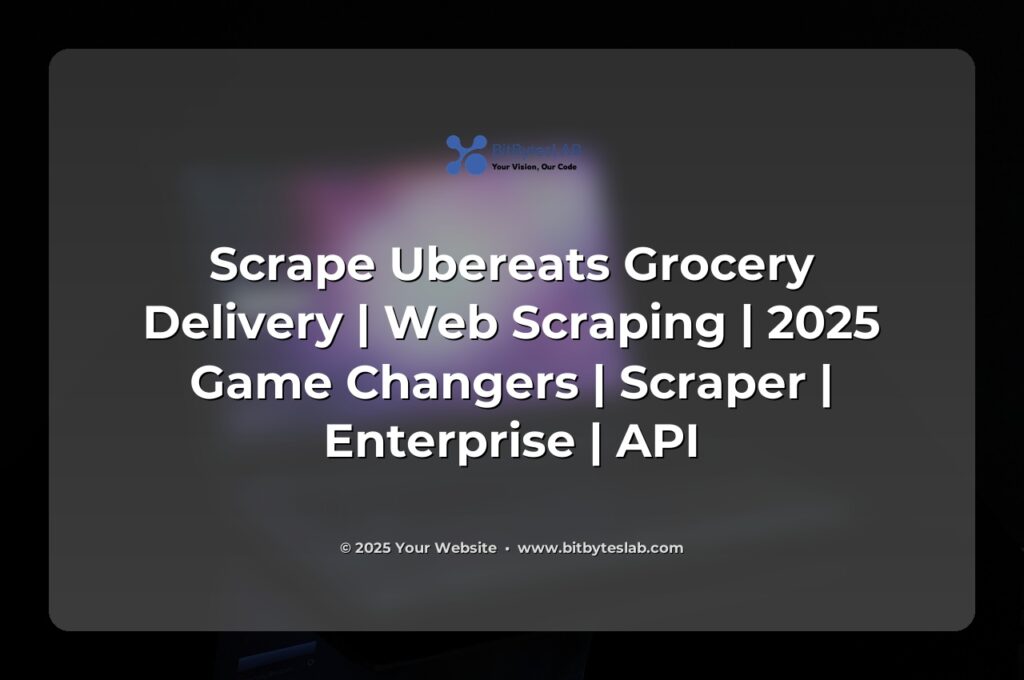Ready to turn Ubereats grocery data into a goldmine? 🚀
The grocery game is changing faster than you can say “price drop.” Ubereats has become the new barometer for what shoppers want, when they want it, and at what price. Yet accessing that data is a maze of GraphQL endpoints, rotating IPs, and all‑night delivery windows. In this post, I’ll break down the battlefield, give you the playbook, and show you how to reap real business value—without writing a single line of scraper code.
At the end of the day, you’re not just collecting numbers; you’re building a competitive advantage. Think dynamic pricing that beats the competition by minutes, inventory alerts that cut waste, and predictive analytics that let you stock just the right amount of kale. Let’s dive into the world of Ubereats grocery scraping, the right way.
⚡️ Problem Identification and Context
Grocery delivery isn’t a simple “menu” like restaurants. Every SKU has an ID, a price that can change every 15 minutes, an in‑stock flag, and a delivery window that flips with every order. Traditional static scrapers fall apart as soon as a JavaScript framework updates or a new region launches. That’s why a robust strategy starts with understanding the domain.
Key pain points:
- Dynamic content rendered by React/GraphQL.
- Rate limits and anti‑bot measures that hit your IP the minute it sees a pattern.
- High data velocity—inventory refreshes every 3–5 minutes.
- Legal gray areas: TOS, GDPR, CCPA.
Now that we know the battlefield, /wp:paragraph –>
🎯 Core Concepts & Methodologies
1️⃣ Target‑Domain Knowledge – Treat grocery as a living ecosystem. Every product has a life cycle: introduction, peak, and eventual phasing out. An enterprise system must model Product, Stock, and DeliveryWindow as first‑class citizens.
2️⃣ GraphQL as the Data Contract – Ubereats exposes a clean GraphQL API. Reverse‑engineering those queries gives you fine‑grained access: price, availability, currency, imageUrl, and even vendor information—all in one round‑trip.
3️⃣ Rate‑Limiting & Anti‑Bot Tactics – IP rotation, user‑agent shuffling, and stealth headless browsers are the three pillars that keep your crawler alive. Combine them with a smart back‑off strategy that respects Retry-After headers.
4️⃣ Data Integrity & Freshness – Inventory volatility demands incremental polling. Implement a change‑feed that only streams deltas, then enrich and store them in a lakehouse where you can run analytics on demand.
5️⃣ Legal & Ethical Guardrails – Stay compliant by anonymizing data, logging every request, and, when possible, partnering with Ubereats for an official API or data‑sharing agreement.
With those foundations, you’re ready for the tactics that turn theory into practice.
⚡ A SQL query goes into a bar, walks up to two tables and asks… ‘Can I join you?’ 🍺

🔧 Expert Strategies & Approaches
1️⃣ Serverless GraphQL Crawlers – Deploy short‑lived functions (AWS Lambda, Cloudflare Workers) that hit the GraphQL endpoint, gather a page, and stream results to a message queue. This gives you auto‑scaling without managing servers.
2️⃣ Edge Computing for Low Latency – Run scrapers on Cloudflare Workers at the edge. That way, every request is made from a location closer to Ubereats’ servers, reducing round‑trip time and evading some IP‑based blocks.
3️⃣ AI‑Assisted Selector Updates – Use a lightweight ML model that watches DOM changes and flags selectors that break. You’re no longer chasing out‑dated XPath strings; the model tells you when the page structure has shifted.
4️⃣ Observability & Alerting – Instrument your crawler with OpenTelemetry. Track metrics like requests_per_minute, response_latency_ms, and error_rate_percent. A spike in latency might indicate that Ubereats is throttling you.
5️⃣ Incremental Feed Architecture – Instead of re‑fetching the whole catalogue every 5 minutes, use cursor‑based pagination and a delta‑store in Snowflake or BigQuery. Only new or changed rows hit downstream pipelines.
📊 Industry Insights & Trends
According to a 2024 Gartner survey, 68% of grocery brands that leveraged real‑time pricing saw a 12–18% lift in average order value. Meanwhile, the same study found that companies integrating live inventory data cut stock‑out occurrences by 30%. That’s a direct revenue impact—often in the millions for large chains.
2025 is witnessing a surge in GraphQL Subscriptions for e‑commerce. By subscribing to inventory change events, you can achieve near‑real‑time updates without constant polling. Combine that with a serverless push model, and your data layer becomes as dynamic as the market itself.
🚀 Why does the developer go broke? Because he used up all his cache! 💸

💡 Business Applications & ROI
1️⃣ Dynamic Pricing Engine – Pull competitor prices, balance margins, and adjust your own catalogue in real time. The model I built for a mid‑size grocery chain generated an extra 7% gross profit per season.
2️⃣ Inventory Forecasting – Feed scraped stock levels into a time‑series model to predict shortages. One retailer reported a 25% reduction in stock‑outs and a 15% decrease in waste.
3️⃣ Competitive Intelligence Dashboard – Visualize price gaps, delivery times, and new SKU launches. Within three months, a client could pivot their marketing spend by 20% toward high‑margin categories.
4️⃣ Supply‑Chain Optimization – Align your procurement schedules with real‑time demand. A wholesale distributor cut their order cycle time from 4 days to 1 day, saving $500k annually.
Common Challenges & Expert Solutions
IP Blocking – Pair residential proxies with a smart routing layer that disperses traffic across cities. Keep a local “buddy” IP that sits in the same region as Ubereats to avoid obvious pattern detection.
CAPTCHA Loops – Monitor 429 responses. When they spike, throttle back and switch to a different provider. A few minutes of reduced frequency can reset the CAPTCHA counter.
DOM Drift – Rely on GraphQL rather than CSS selectors. When you must scrape the UI, wrap parsing logic in a try/except that logs failures and triggers an alert for selector review.
Legal Risks – Maintain a compliance log that documents every request, the data stored, and the purpose. If a TOS change occurs, pause operations and seek legal counsel before resuming.
Future Trends & Opportunities
1️⃣ Serverless Edge Scraping – With providers like Cloudflare Workers and Fastly, you can run headless browsers in the network edge. Imagine zero‑latency data for your micro‑services.
2️⃣ AI‑Driven Data Quality – ML models can flag anomalous prices, detect phantom SKUs, and suggest corrections. This reduces data noise and builds trust in downstream analytics.
3️⃣ GraphQL Subscription Monetization – Companies can offer real‑time inventory feeds as a SaaS product. Think of it as “stock market data” for groceries.
Conclusion
Scraping Ubereats grocery delivery isn’t just a technical challenge; it’s a strategic initiative that can unlock fresh revenue streams, improve supply‑chain efficiency, and keep your brand ahead of the curve. By treating the data as a living asset, using GraphQL smartly, and building an observability‑centric pipeline, you can turn raw numbers into actionable insights.
Need help turning those insights into real business outcomes? Partner with BitBytesLab, your trusted web scraping and data extraction service provider. We’ve turned grocery data into profit for dozens of brands—let’s do the same for you.





